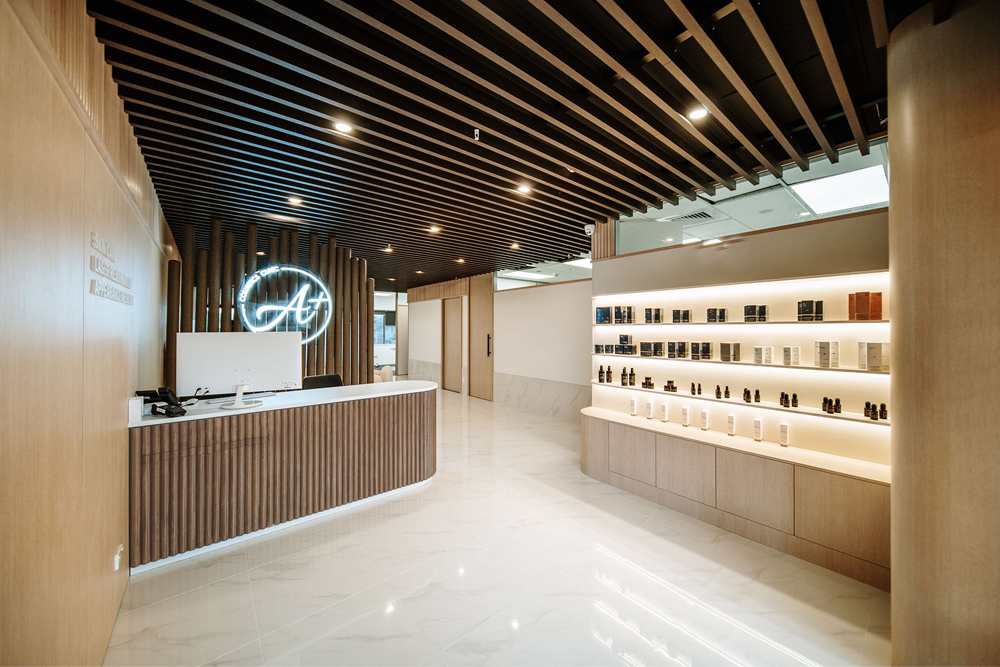Creating a Productive Workspace
 M8 FITOUT
M8 FITOUT
Did you know that happy employees are 12% more productive than an average employee? A positive work environment leads to lower turnover rates, improved customer service, increased cost and time efficiency, fewer sick days, higher profits, and a positive company culture. You can create this atmosphere in your office by creating a well-designed workspace. Such well-planned interiors are a crucial factor in fostering productivity and enhancing employee satisfaction, plus it’s aesthetically pleasing too! This comprehensive guide explores the essential elements of creating a productive workspace, tailored specifically for businesses looking to revamp their office environments. Let’s get in:
First Things First: What is a Productive Workspace Design? A productive workspace is created specifically to support the physical and psychological needs of employees. It facilitates focus, encourages collaboration, and promotes the well-being of your staff. The primary goal here is to create an environment where employees can perform their best work comfortably and efficiently. This can range from making small changes in your commercial interior design or modifying your entire office fit-out to suit your staff and the type of job they are engaged in.
Key Elements for Designing a Productive Workspace
Today, work and home have blended into everyday life, raising the concept called ‘recimercial’. This refers to the blend of the residential interior with commercial fit-out to bring the comfort of home to the office. Lounges with cosy sofas and kitchen spaces to make your own coffee, these fit-outs will promote employees’ mental well-being to stay balanced and avoid burnout when deadlines approach.
This doesn’t mean you are recreating a home in the office. Instead, get the inspirations of home or what it feels like when you enter a hospitality setting to create a sense of calmness in your employees. This can positively affect overall productivity.
Natural Light and Air Quality
As we always say in our blog posts, natural light is one of the most critical factors in workspace design. Exposure to natural light improves mood, boosts vitamin D levels, and supports the body’s circadian rhythms, leading to better sleep, more energy and overall health. Research by Cornell University revealed that office workers with natural daylight experienced an 84% decrease in issues such as headaches and eye strain. Another study found that access to natural light and views of the outdoors is the number one attribute of the workplace environment, outranking any other perks a company would offer.
Consider the following tips to maximise natural light in your office:
Place workstations near windows to ensure that employees receive adequate daylight.
Use light-reflective surfaces and materials to enhance the distribution of natural light.
Install skylights or light tubes in areas with limited access to windows.
Apart from this, maintaining good air quality is also essential to make your office workspace better. Poor air quality can lead to health issues and decreased productivity. You can add plants to the office to improve air quality. This provides numerous psychological benefits. According to the World Green Building Council, increasing fresh air supply to the workstation can boost productivity by 11%.
Consider incorporating air filtration systems and ensuring proper ventilation to maintain a healthy indoor environment. Simple measures like opening windows and using air purifiers can make a substantial difference.
Ergonomic Furniture
This refers to furniture that fits your body, to maintain its posture. Such ergonomically designed furniture reduces discomfort and prevents injuries. When you are looking for fit-out solutions, invest in adjustable chairs, sit-stand desks, and computer risers that can make a significant impact on employee well-being and productivity. Ergonomic furniture helps maintain proper posture, reduces strain on the body and above all, it minimises the risk of musculoskeletal disorders by 60%.
Key ergonomic considerations include:
Adjustable chairs that support the lower back and allow height adjustments.
Desks that accommodate both sitting and standing positions.
Monitor stands that position screens at eye level to prevent neck strain.
Colour Psychology
The use of colour in the workspace can significantly influence the mood and productivity of your staff. Different colours evoke different psychological responses, making it important to choose the right colours for various office areas.
For instance, green promotes calmness and reduces anxiety, making it ideal for relaxation areas and quiet zones. Blue improves focus and productivity. This is suitable for workspaces where concentration is needed. On the other hand, if you need to stimulate creativity and energy, try adding yellow to your office colour scheme. This is great for brainstorming areas and collaborative spaces and if you are looking for a colour scheme for a restaurant fit-out, go for earthy tones to create a welcoming environment.
Thus, consider the function of each area and the overall brand identity of your business when selecting colours. A well-thought-out colour scheme can create a visually appealing environment that supports different work activities.
Clutter-Free Environment
A clutter-free workspace is essential for maintaining focus and reducing stress. Physical clutter can be distracting and create a sense of chaos, while digital clutter can overwhelm employees and decrease productivity. Keeping the workspace organised and tidy helps employees concentrate on their tasks and improves overall efficiency.
Here are some tips for maintaining a clutter-free environment:
Providing ample storage solutions such as shelves, cabinets, and drawers.
Encouraging employees to keep their workstations clean and organised.
Implementing regular decluttering sessions to remove unnecessary items.
Designing Workspaces for Different Work Styles
As a company, you should be able to design workspaces tailored to different work styles, depending on what the job demands. This is important to foster productivity, collaboration, and employee satisfaction. By acknowledging and accommodating those differences, companies can create spaces that enhance focus, creativity, and overall well-being.
Quiet Zones
Quiet zones are essential for tasks that require deep concentration and focus. These areas help employees stay focused and reduce stress, leading to higher-quality work and increased productivity. Quiet zones should be free from distractions and noise, providing employees with a peaceful environment to work on complex projects.
To create effective quiet zones:
Position quiet areas like focus pods, away from high-traffic zones and noisy equipment.
Use soundproofing materials such as acoustic panels and carpets to minimise noise.
Provide comfortable seating and adequate lighting to improve the working experience.
Collaboration Spaces
Collaboration is vital for innovation and problem-solving. Designated collaboration spaces encourage teamwork and facilitate communication among team members. Businesses can foster a culture of teamwork and creativity through this. These areas should be flexible, allowing for different group sizes and activities.
Effective collaboration spaces should include:
Large tables and comfortable seating to accommodate group discussions and brainstorming sessions.
Whiteboards, projectors, and other tools to support visual communication, brainstorming and idea sharing.
Flexible furniture arrangements that can be easily reconfigured to suit different needs.
Break Areas
Your employees need a break from work to recharge themselves. These spaces allow employees to relax and socialise, which can improve morale and reduce burnout. A well-designed break area can significantly enhance the overall work environment.
Key elements of a successful break area include:
Comfortable seating and a relaxed atmosphere.
Recreational activities such as games, books, and magazines.
Amenities like coffee machines, snacks, and water coolers.
Read Additional Design Tips for a Happy Workplace

Subscribe to my newsletter
Read articles from M8 FITOUT directly inside your inbox. Subscribe to the newsletter, and don't miss out.
Written by
